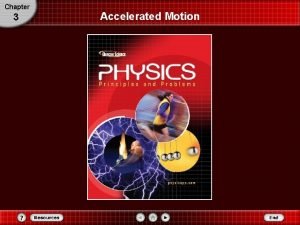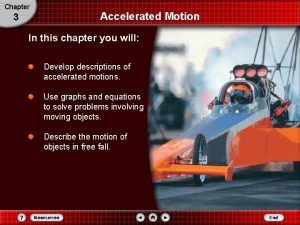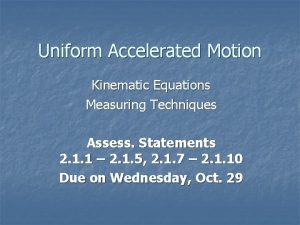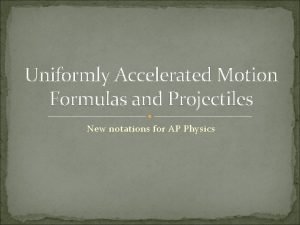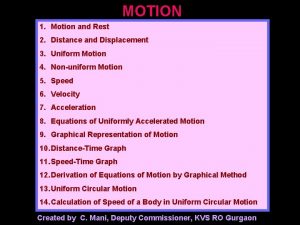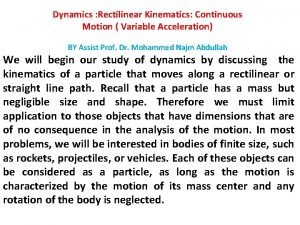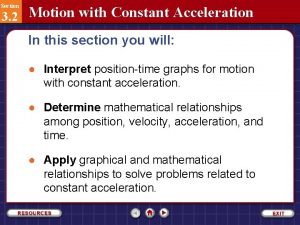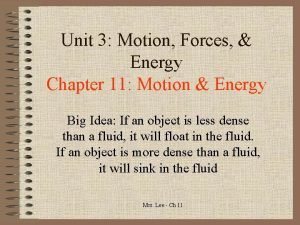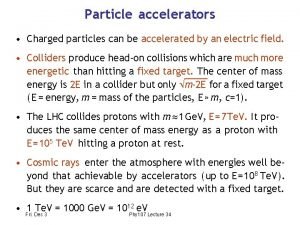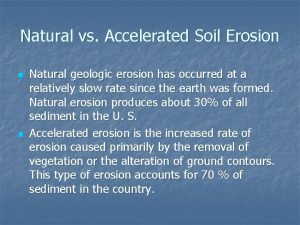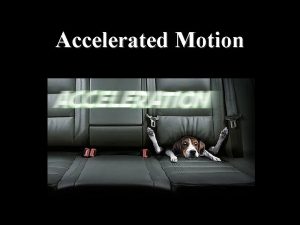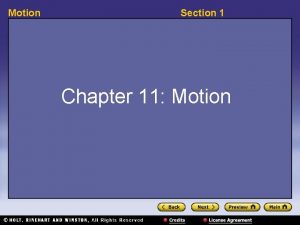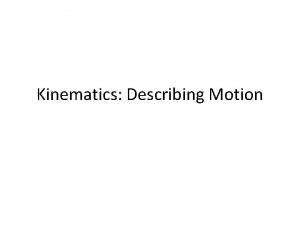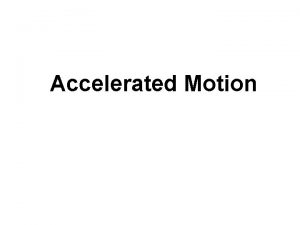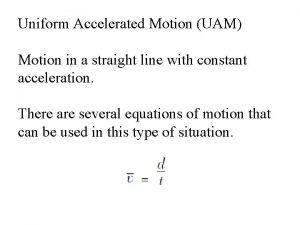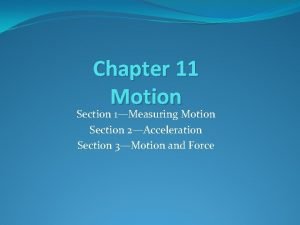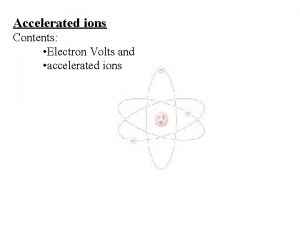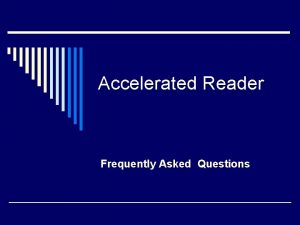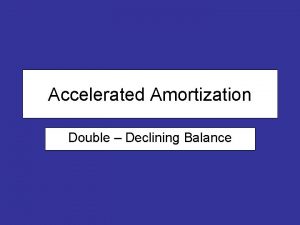Chapter 3 Accelerated Motion Section 3 1 p































- Slides: 31

Chapter 3 Accelerated Motion

Section 3. 1 p Essential Questions: n n n What is acceleration? How is acceleration different from velocity? What information can you learn from velocitytime graphs?

Section 3 -1 Acceleration p Nonuniform Motion Diagrams n You can feel a difference between uniform and nonuniform motion. Uniform feels smooth. p Nonuniform motion you might feel pushed or pulled. p

Particle Model Diagram p The change in spacing of the dots and the differences in the lengths of the velocity vectors indicate the changes in velocity. n (Remember, velocity vectors are red!)

Displaying Acceleration on a Motion Diagram For a motion diagram to give a full picture of an object’s movement, it should contain information about the rate at which the object’s velocity is changing. p Acceleration is the rate at which velocity changes. p n n n Acceleration can be either positive or negative. Acceleration is a vector quantity. Acceleration vectors are normally violet.

Finding Acceleration Vectors p p p The acceleration is zero in the first example since the velocity vectors are the same size. The acceleration is positive in the second example since the velocity is increasing. The acceleration is negative in the last example since the velocity is decreasing.

Direction of Acceleration p To find the direction using velocity vectors, we will take the final velocity vector and subtract the initial velocity vector from it.

Velocity-Time Graphs p On a velocity-time graph, velocity is plotted on the vertical axis (y) and time is plotted on the horizontal axis (x). n n The slope on a velocity-time graph is equal to acceleration. The area under the curve on a velocity-time graph is equal to displacement.

Velocity-Time Graph Constant Velocity = No Acceleration Speeding Up = + Acceleration Slowing Down = - Acceleration Speeding Up in Reverse = - Acceleration Slowing Down in Reverse= + Acceleration

Average Acceleration p Average acceleration is a change in velocity over a change in time. n n n a = v = (v 2 - v 1) t (t 2 - t 1) Units are usually m/s/s or m/s 2. When going in a positive direction: An increase in velocity is a positive acceleration. p A decrease in velocity is a negative acceleration. p n When going in a negative direction: An increase in velocity is a negative acceleration. p A decrease in velocity is a positive acceleration. p

Ex #1. The velocity of a car increases from 2. 0 m/s at 1. 0 s to 16 m/s at 4. 5 s. What is the car’s average acceleration? a = v t a = (v 2 - v 1) (t 2 - t 1) a = (16 m/s - 2. 0 m/s) (4. 5 s - 1. 0 s) a = (14 m/s) (3. 5 s) a = 4. 0 m/s 2

Instantaneous Acceleration p p The change in an object’s velocity at an instant of time is called instantaneous acceleration. You can determine the instantaneous acceleration of an object by drawing a tangent line on the velocitytime graph at the point of time in which you are interested.

Acceleration with Constant Speed p Acceleration can occur even when speed is constant. n A change in velocity results in acceleration. p If an object changes direction, but not speed, it accelerates.

Section 3. 2 Motion with Constant Acceleration p Essential Questions: n n n What do a position-time graph and a velocitytime graph look like for motion with constant acceleration? How can you determine the displacement of a moving object from its velocity-time graph? What are the relationships among position, velocity, acceleration, and time?

Position with Constant Acceleration p Constant acceleration (uniform) acceleration does not change. n n The velocity-time graph of constant acceleration produces a straight line. The position-time graph of constant acceleration produces a curved line.

Derive Time! Constant acceleration a = v t a = (vf - vi) t at = vf - vi at + vi = vf vf = vi + at

Ex #2. If a car with a velocity of 2. 0 m/s at t = 0 accelerates at a rate of +4. 0 m/s 2 for 2. 5 s, what is its velocity at time t = 2. 5 s? vf = vi + at vf = (2. 0 m/s) + (4. 0 m/s 2)(2. 5 s) vf = (2. 0 m/s) + (10. m/s) vf = 12 m/s

p We will derive three more equations to use, and only use, when acceleration is constant.

Derive Time! Average velocity v = (vf + vi) 2 v = ½ (vf + vi) velocity equals displacement over time d/t = ½ (vf + vi) d = ½ (vf + vi)t

Ex #3. What is the displacement of a train as it is accelerated uniformly from +11 m/s to +33 m/s in a 20. 0 s interval? d = ½ (vf + vi)t d = ½ (33 m/s + 11 m/s)(20. 0 s) d = ½ (44 m/s)(20. 0 s) d = 440 m

Derive Time! d = ½ (vf + vi)t acceleration equals velocity over time a=v t v = at Substitute (vi + at) in for vf d = ½ ((vi + at) + vi )t d = ½ (2 vi + at)t d = vit + ½ at 2

Ex #4. A car starting from rest accelerates uniformly at +6. 1 m/s 2 for 7. 0 s. How far does the car move? d = vit + ½ at 2 d = (0. 0 m/s)(7. 0 s) + ½ (6. 1 m/s 2)(7. 0 s)2 d = 0 + ½ (6. 1 m/s 2)(49 s 2) d = 149. 45 m d = 150 m

Derive Time! We know d = ½ (vf + vi)t and vf = vi + at Solve the second equation for t. t = (vf - vi)/a Substitute t d = ½ (vf + vi)[(vf - vi)/a] d = ½ [(vf + vi)(vf - vi)]/a 2 ad = [(vf + vi)(vf - vi)] 2 ad = [vf 2 - vi 2] vf 2 = vi 2 + 2 ad

Ex #5. An airplane must reach a velocity of 71 m/s for takeoff. If the runway is 1. 0 km long, what must the constant acceleration be? vf 2 = vi 2 + 2 ad (71 m/s)2 = (0. 0 m/s)2 + 2 a(1000 m) 5041 m 2/s 2 = 0 + (2000 m) a 5041 m 2/s 2 = (2000 m) a a = (5041 m 2/s 2) / (2000 m) a = 2. 5205 m/s 2 a = 2. 5 m/s 2

Equations of Motion for Uniform Acceleration Equation vf = vi + at Variables vi vf d = ½ (vf + vi)t vi d vf d = vit + ½ at 2 vi d vf 2 = vi 2 + 2 ad vi d a t a vf t a t

Section 3. 3 Free Fall p Essential Question: n n What is free-fall acceleration? How do objects in free fall move?

p In 1971, astronaut David Scott dropped a hammer and a feather at the same time from the same height above the Moon’s surface. The hammer’s mass was greater, but both objects hit the ground at the same time because the Moon has gravity but no air. (video)

Galileo’s Discovery p Free fall is the motion of an object when gravity is the only significant force acting on it. n p Galileo was the first to show that all objects fall to Earth with a constant acceleration. The acceleration of an object due only to the effect of gravity is known as free-fall acceleration. n g = -9. 80 m/s 2

Acceleration Due to Gravity p Acceleration Due to Gravity (g) is another name for free-fall acceleration. n n n Any object that is dropped will have an initial velocity of zero. We will assume no air resistance. An object that is thrown upward will have a velocity of zero at the highest point.

Ex #6. The Demon Drop ride at Cedar Point is freely falling at 1. 5 s. How far does it fall? What is it velocity at the end of this time? d = vit + ½ at 2 We will substitute g in for a d = vit + ½ gt 2 d = 0 + ½ (-9. 80 m/s 2)(1. 5 s)2 d = - 11 m vf = vi + gt vf = 0 + (-9. 80 m/s 2)(1. 5 s) vf = -14. 7 m/s vf = -15 m/s

Variations in Free Fall p As the distance from Earth increases, the effect of freefall acceleration decreases. n n n p New York City = - 9. 81 m/s 2 Denver = - 9. 79 m/s 2 Moon’s surface = -1. 6 m/s 2 For calculation in this chapter, a value of -9. 80 m/s 2 will be used for free-fall acceleration.
 Chapter 3 accelerated motion
Chapter 3 accelerated motion Chapter 3 accelerated motion practice problems answers
Chapter 3 accelerated motion practice problems answers Chapter 2 section 1 describing motion answer key
Chapter 2 section 1 describing motion answer key What is acceleration
What is acceleration Motion section 1 describing motion
Motion section 1 describing motion Kinematic equations for uniformly accelerated motion
Kinematic equations for uniformly accelerated motion Uniformly variable rectilinear motion
Uniformly variable rectilinear motion Uniform acceleration formulas
Uniform acceleration formulas Uniformly accelerated motion
Uniformly accelerated motion Graphical representation of motion
Graphical representation of motion Uniformly accelerated motion formula
Uniformly accelerated motion formula Describing and measuring motion worksheet answer key
Describing and measuring motion worksheet answer key Section 1 describing motion
Section 1 describing motion Section 3 acceleration
Section 3 acceleration Section 3 motion and forces worksheet answers
Section 3 motion and forces worksheet answers Describing and measuring motion
Describing and measuring motion Natalie accelerates her skateboard
Natalie accelerates her skateboard Mrs lee chapter 11
Mrs lee chapter 11 Chapter 10 section 1: meiosis
Chapter 10 section 1: meiosis Range of motion definition
Range of motion definition Simple harmonic motion equations
Simple harmonic motion equations An object in motion stays in motion
An object in motion stays in motion Accelerated graphic port
Accelerated graphic port Accelerated learning cycle
Accelerated learning cycle Charged particles can be accelerated by
Charged particles can be accelerated by Differentiate between geological and accelerated erosion
Differentiate between geological and accelerated erosion Reading renaissance ljisd
Reading renaissance ljisd Calibrated accelerated life testing
Calibrated accelerated life testing Project arrow 204
Project arrow 204 Azure accelerated networking: smartnics in the public cloud
Azure accelerated networking: smartnics in the public cloud Accelerated reading test answers
Accelerated reading test answers Ar test answers doc
Ar test answers doc
